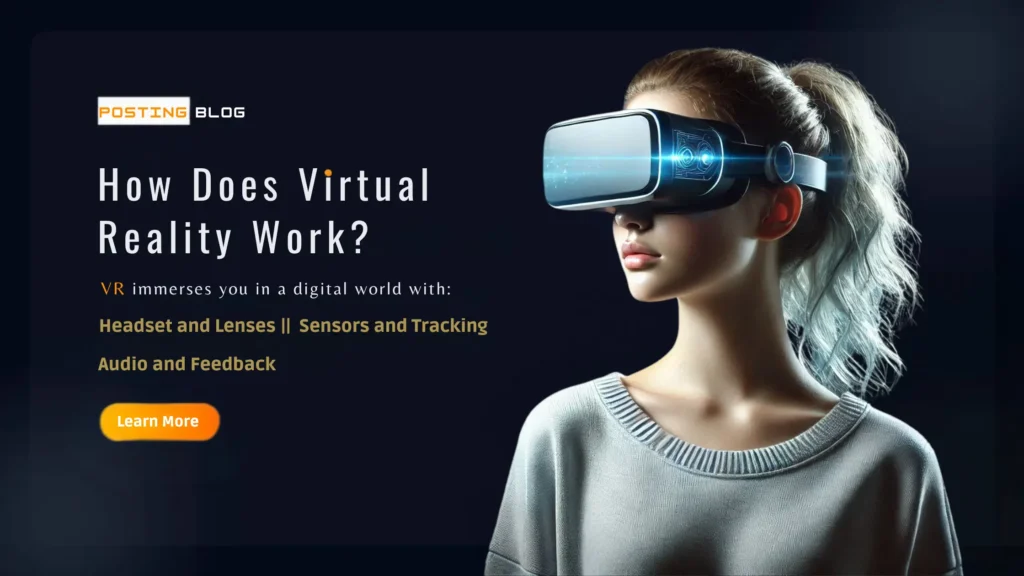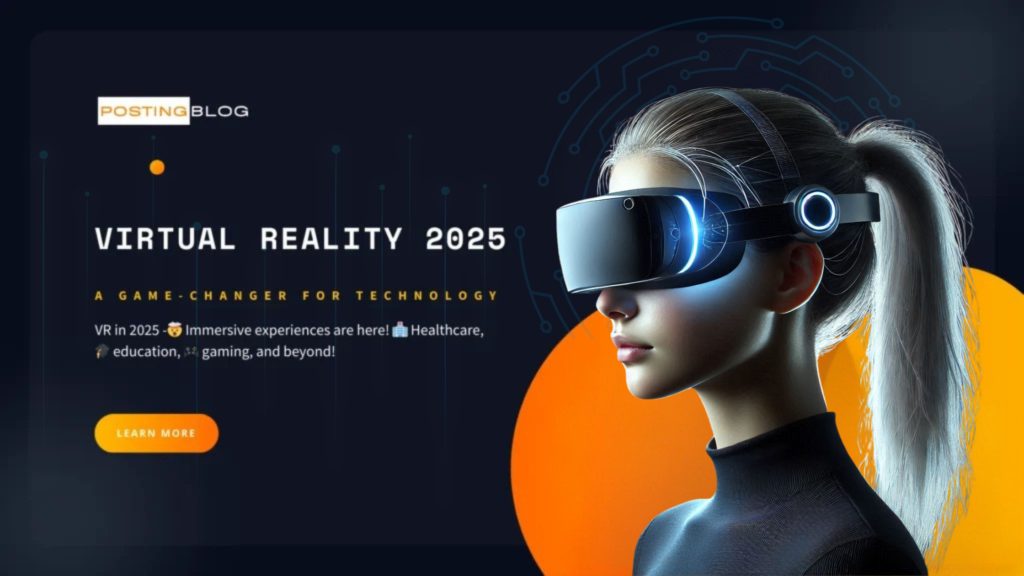Virtual Reality (VR) is no longer a futuristic concept, but an immersive technology reshaping industries, entertainment, and even healthcare. Over the past decade, VR has evolved from being a niche gaming experience to a versatile tool used in education, training, medicine, and business. As we approach 2025, Virtual Reality is expected to continue transforming our daily lives, offering new ways to interact with the digital world. This blog explores the workings of VR, its applications, and what we can expect from Virtual Reality 2025.
What is Virtual Reality?
Virtual Reality (VR) is a computer-generated environment that simulates a user’s physical presence in a virtual or imagined world. Unlike traditional media, VR allows users to interact with 3D environments using specialized hardware, such as a VR headset. Through visual, auditory, and sometimes tactile feedback, VR provides a fully immersive experience that feels real, despite the user being physically in a different space.
At its core, VR leverages the human senses to create the illusion of presence. With VR, you can experience the thrill of soaring through space, performing surgery, or exploring the depths of the ocean—all from the comfort of your home or office.
How Does Virtual Reality Work?
The magic of VR lies in the immersive experience it offers. When you put on a Virtual Reality headset, you’re instantly transported into a digital world, where your movements and actions are tracked and reflected in real time.

- Headset and Lenses: The primary device for VR is the VR headset, a goggle-like piece of equipment worn on the head. Inside the headset, two lenses create a stereoscopic effect by displaying separate images for each eye. This effect gives depth to the 3D environment, making it feel more realistic.
- Sensors and Tracking: VR headsets are equipped with motion sensors, accelerometers, and gyroscopes that track your head movement. The system detects the direction and rotation of your head, adjusting the virtual environment accordingly. Some advanced VR systems also include hand controllers or motion sensors to track the user’s body movements, further enhancing the feeling of immersion.
- Audio and Feedback: In addition to visual stimuli, VR often includes spatial audio, which enhances realism by making sounds appear to come from specific directions in the virtual environment. Haptic feedback, provided by special gloves or controllers, can also simulate the sense of touch, adding another layer of realism.
Applications of Virtual Reality
The uses of VR are diverse and have spread far beyond its gaming roots. Today, VR is a tool for training, education, healthcare, design, and even social interaction. Let’s take a closer look at some of the major fields where VR is making a difference:
1. Gaming and Entertainment
When most people think of VR, they think of video games. Over the years, VR has become an essential part of the gaming experience. Games like Beat Saber and Half-Life: Alyx use the full capabilities of VR to immerse players in virtual worlds where they can interact with their surroundings and characters in a way that traditional gaming consoles cannot replicate.
With VR, gaming is no longer just about watching the screen—it’s about being part of the action. As technology advances, games are becoming even more realistic, thanks to improvements in graphical fidelity, sound design, and interactive elements.
2. Education and Training
In education, VR has proven to be an invaluable tool for immersive learning experiences. Virtual classrooms and VR simulations allow students to interact with subjects in ways that textbooks and traditional lessons simply can’t match. Whether it’s practicing surgical techniques in a virtual operating room or exploring historical events firsthand, VR is revolutionizing how we learn.
For industries like aviation, VR is used to simulate real-world scenarios for training pilots without the risks of flight. In medicine, doctors and surgeons use VR to rehearse complex surgeries before performing them on actual patients, reducing the margin for error.
3. Healthcare
VR is having a profound impact on healthcare, both in patient treatment and medical training. In therapeutic settings, VR helps treat patients with anxiety disorders, PTSD, and phobias by immersing them in controlled environments where they can confront their fears in a safe space. For example, patients with social anxiety can practice public speaking in virtual crowds, while those with PTSD can relive traumatic events in a controlled, therapeutic way.
Additionally, VR plays a crucial role in pain management. For burn victims or patients undergoing painful treatments, VR can be used as a distraction to help them cope with discomfort by engaging their mind in an immersive digital environment.
4. Real Estate and Architecture
Real estate agents and architects are using VR to showcase properties and design projects. With a VR headset, potential buyers can take a virtual tour of a property without leaving their homes. This is particularly useful for remote buyers or those with limited time to view properties in person.
In architecture, VR allows designers to visualize building plans and spaces in 3D, helping them make design decisions before construction begins. It allows for real-time collaboration between clients, architects, and contractors, reducing errors and improving project efficiency.
5. Remote Work and Virtual Collaboration
The COVID-19 pandemic pushed many businesses toward remote work, and VR is enhancing how employees collaborate in virtual environments. Platforms like Spatial and AltspaceVR allow colleagues to meet and interact in 3D virtual meeting rooms, making remote work feel more engaging and productive. In VR, participants can walk around virtual office spaces, use whiteboards, and share presentations just as they would in a physical meeting.
As more companies shift to hybrid and remote models, VR will play a significant role in maintaining connection and collaboration among teams across the globe.
6. Social Interaction and Virtual Travel
Social VR platforms like VRChat and Rec Room allow users to interact with friends and strangers in virtual spaces. These platforms offer a level of engagement that goes beyond traditional social media, where users can interact via avatars and engage in games, parties, or discussions.
Additionally, VR has made virtual travel possible. Virtual Reality 2025 is likely to see more people exploring the world from the comfort of their homes. Through VR headsets, users can visit iconic landmarks, wander through museums, or even take a stroll on Mars, experiencing locations in immersive 3D detail.
The Future of Virtual Reality: What to Expect in 2025
As we approach Virtual Reality 2025, the technology is set to become even more refined and integrated into everyday life. Here’s a glimpse into what the future holds:
- Improved Graphics and Realism: As computing power increases and technology improves, the quality of VR graphics will continue to enhance. The next generation of VR headsets will offer better resolutions, faster refresh rates, and more realistic visual effects, making virtual environments even more lifelike.
- Wireless and More Comfortable Headsets: Future VR headsets will become lighter, more comfortable, and more wireless. Devices like the Meta Quest 3 have already made significant strides in eliminating cables, but future devices will likely become even more seamless, allowing users to move freely without restrictions.
- Integration with AI and Machine Learning: As AI continues to evolve, VR experiences will become smarter. Artificial intelligence could power more responsive and personalized virtual environments, adapting to user preferences and actions in real-time.
- Enhanced Social Experiences: Social VR platforms will become more sophisticated, allowing users to create highly personalized avatars and environments. Virtual social interactions will feel increasingly authentic, providing new opportunities for networking, collaboration, and entertainment.
- Broader Accessibility and Affordability: As VR becomes more mainstream, the cost of headsets will continue to decrease, making the technology more accessible to a broader audience. More industries will incorporate VR into their workflows, making it a common tool in everything from customer service to mental health treatment.
Conclusion – Virtual Reality
Virtual Reality is undoubtedly a transformative technology that has the potential to change how we live, work, and interact with the world. As we approach 2025, VR will only continue to evolve, offering more immersive, practical, and engaging experiences across a wide array of industries. Whether it’s through gaming, education, healthcare, or virtual travel, Virtual Reality is poised to redefine our digital future.
With advancements in VR headsets, motion tracking, and interactive experiences, the potential for VR is vast. From transforming the way we work and learn to creating immersive worlds for entertainment and social interaction, the next few years promise to be an exciting time for Virtual Reality innovation.



